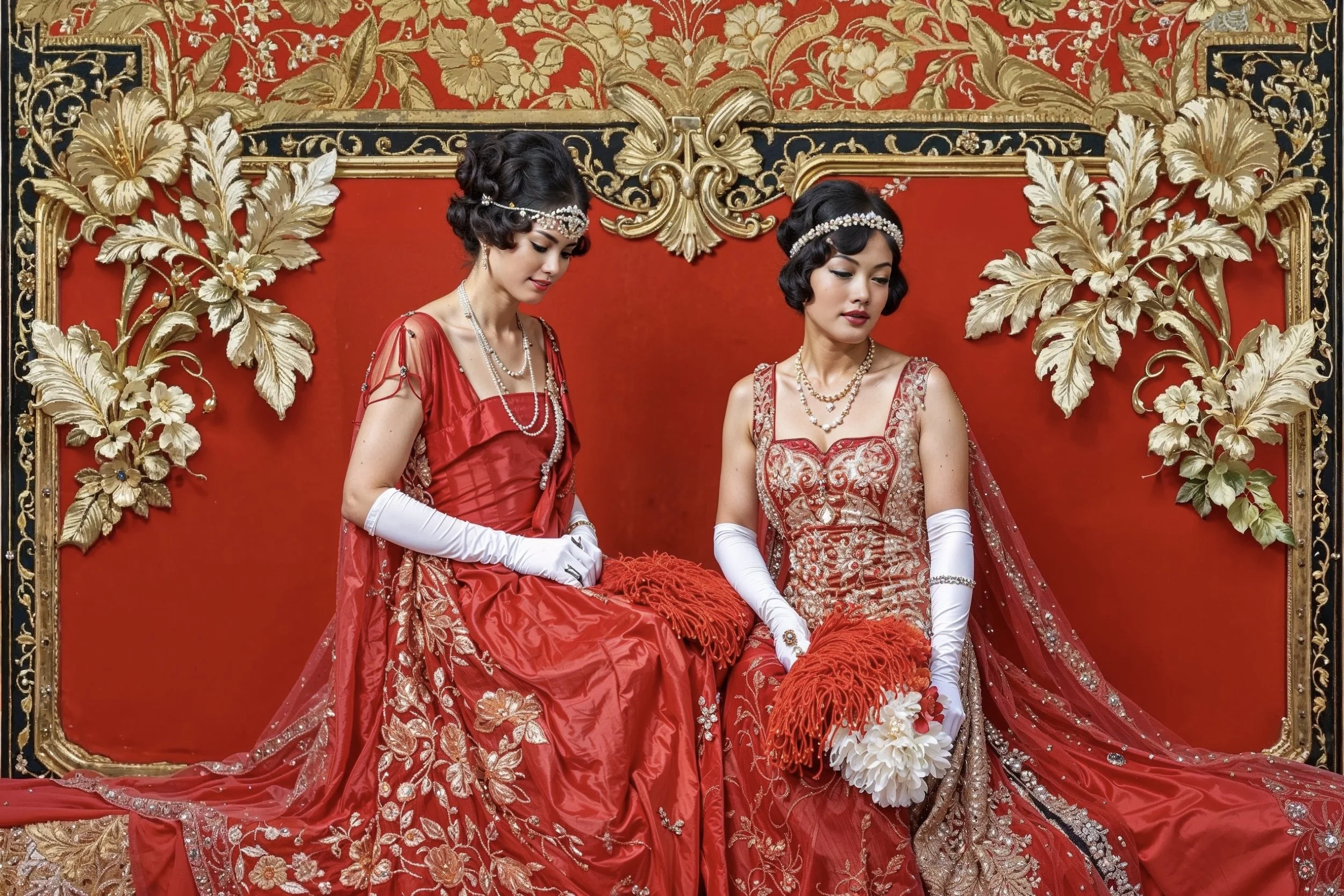แฟชั่นราชสำนักสยามสไตล์อาร์ตเดโค สมัยรัชกาลที่ ๖: แรงบันดาลใจจากงานลงยาราชาวดี (ตอนที่ 3)
แฟชั่นราชสำนักสยามสไตล์อาร์ตเดโค สมัยรัชกาลที่ ๖: แรงบันดาลใจจากงานลงยาราชาวดี (ตอนที่ 3)
คอลเลกชันนี้คือการจินตนาการใหม่ของเครื่องแต่งกายราชสำนักสยามในสมัยรัชกาลที่ ๖ (พระบาทสมเด็จพระมงกุฎเกล้าเจ้าอยู่หัว ครองราชย์ระหว่าง พ.ศ. ๒๔๕๓–๒๔๖๘) ถ่ายทอดผ่านเลนส์แห่งความหรูหราของยุคอาร์ตเดโคในคริสต์ทศวรรษ 1920 ผสานกับความวิจิตรของศิลปะลงยาราชาวดี (Cloisonné Enamel) โดยทุกรายละเอียด—ตั้งแต่รูปทรงชุด เครื่องประดับ ไปจนถึงฉากหลัง—ล้วนได้รับการออกแบบอย่างพิถีพิถันในโทนสีร้อนที่หายากและมีคุณค่าทางประวัติศาสตร์และศิลปะ ได้แก่:
Ruby Red / Rose Red จาก gold chloride – สีแดงสดจัด เปล่งประกาย หรูหรา (ฝรั่งเศส, เยอรมนี)
Deep Red / Blood Red จาก copper oxide – สีแดงเข้ม ลุ่มลึก ดั่งโลหิต (ชิลี, ไซปรัส)
Brick Red / Rust Red จาก iron oxide – สีแดงหม่นอย่างเป็นธรรมชาติ (อินเดีย, จีน, แอฟริกาเหนือ)
Vermilion / Orange-Red จาก cadmium compounds – สีแดงอมส้มจัดจ้าน (เยอรมนี, แคนาดา)
นิยามใหม่ของชุดราชสำนักในแบบคริสต์ทศวรรษ 1920
แรงบันดาลใจจากยุค flapper ทำให้ชุดในคอลเลกชันนี้มีเส้นสายตรง เรียบง่าย แต่เปี่ยมด้วยเสน่ห์แห่งการเคลื่อนไหว ด้วยช่วงเอวต่ำและชายผ้าที่ยาวพลิ้ว ผสานความหรูหราสไตล์ตะวันตกกับความอ่อนช้อยละเมียดละไมแบบไทยราชสำนัก งานปักลูกปัด ดิ้นเงินดิ้นทอง และโลหะประดับสะท้อนลวดลายอันวิจิตรของศิลปะลงยาอย่างกลมกลืน เครื่องแต่งกายจึงมิได้เป็นเพียงแฟชั่นในแบบใดแบบหนึ่ง แต่เป็นการผสมผสานใหม่ที่เหมาะสมกับ "ฤดูกาลออกงานสังคมของผู้ดีสยาม" ที่ถูกจินตนาการขึ้นใหม่
ลงยาราชาวดี: สะพานเชื่อมวัฒนธรรมผ่านงานศิลป์
ศิลปะการลงยาราชาวดีมีรากเหง้าจากยุคไบแซนไทน์ และได้รับการพัฒนาอย่างประณีตในจีนสมัยราชวงศ์หมิง อาศัยกระบวนการขึ้นลวดโลหะเป็นกรอบลาย ก่อนเติมผงเคลือบสีลงในช่องและนำไปเผาที่อุณหภูมิสูง จนได้พื้นผิวเงางามดั่งอัญมณี ในคอลเลกชันนี้ ผมได้ถ่ายทอดแรงบันดาลใจจากศิลปะดังกล่าวผ่านมุมมองแบบ Art Deco ที่เน้นความสมมาตร ชัดเจน เนี้ยบคม ขณะเดียวกันก็ยังสะท้อนอิทธิพลของ Art Nouveau ด้วยเส้นสายโค้งมนอ่อนช้อยและลวดลายธรรมชาติ
บทสนทนาใหม่ระหว่างอดีตกับอนาคต
คอลเลกชันนี้ไม่เพียงแต่สะท้อนความงดงามของแฟชั่นราชสำนักสมัยรัชกาลที่ ๖ หากยังถ่ายทอดศิลปะงานลงยาราชาวดีได้อย่างกลมกลืน ผ่านจินตนาการร่วมสมัยและพลังแห่งเทคโนโลยี AI งานสร้างสรรค์นี้จึงมิใช่เพียงภาพอดีตที่ถูกจินตนาการขึ้นใหม่ หากแต่เป็นบทสนทนาระหว่างประวัติศาสตร์ แฟชั่น และศิลปะ ที่ยังคงเป็นแรงบันดาลใจระหว่างเครื่องแต่งกายกับกระบวนการทางศิลปะอย่างต่อเนื่อง
Siamese Court Fashion in the Art Deco Style during the Reign of King Vajiravudh (Rama VI): Cloisonné Enamel Inspirations (Part 3)
This collection is a reimagining of Siamese court attire during the reign of King Vajiravudh (Rama VI, r. 1910–1925), viewed through the lens of Art Deco opulence from the 1920s and the exquisite craftsmanship of cloisonné enamel. Every detail—whether dress silhouette, accessories, or background setting—has been meticulously designed in rare, historically significant warm tones drawn from mineral-based pigments:
Ruby Red / Rose Red, derived from gold chloride – a vivid, radiant, and luxurious red (France, Germany)
Deep Red / Blood Red, derived from copper oxide – a deep, intense red reminiscent of blood (Chile, Cyprus)
Brick Red / Rust Red, derived from iron oxide – a muted, earthy red (India, China, North Africa)
Vermilion / Orange-Red, derived from cadmium compounds – a bold, fiery orange-red (Germany, Canada)
A New Definition of Court Dress in the 1920s Style
Inspired by the flapper era, the gowns in this collection feature straight, minimalist lines, yet carry the charm of graceful motion, with low waistlines and trailing hemlines. The result is a fusion of Western glamour and Siamese court elegance. Each ensemble is embellished with bead embroidery, silver and gold metallic threads, and ornamental metalwork echoing the intricate patterns of cloisonné art. These creations do not strictly follow traditional Thai fashion or Western dress codes, but instead form a hybrid style tailored for a reimagined “Siamese social season.”
Cloisonné Enamel: A Bridge Between Cultures
Cloisonné enamel is a decorative art with roots in the Byzantine Empire, perfected in China during the Ming Dynasty. The process involves forming tiny wire partitions (cloisons) on a metal surface, filling them with enamel paste, and firing at high temperatures to produce a glossy, gemstone-like finish. In this collection, I draw inspiration from cloisonné artistry, interpreted through the lens of Art Deco—with its symmetry, precision, and bold forms—while subtly incorporating the fluid, organic curves of Art Nouveau, evoking nature’s softness and grace.
A New Dialogue Between Past and Future
This collection not only celebrates the beauty of Siamese court fashion during King Rama VI’s reign but also harmoniously integrates the art of cloisonné enamel through a contemporary lens, empowered by AI technology. It is not merely a nostalgic reconstruction of the past, but a continuing conversation between history, fashion, and art—where garments and decorative processes remain sources of inspiration across time.
#aifashionlab #AI #aiartist #aiart #aifashion #aifashiondesign #aifashionstyling #aifashiondesigner #fashion #fashionhistory #historyoffashion #fashionstyling #fashionphotography #digitalfashion #digitalfashiondesign #digitalcostumedesign #digitaldesign #digitalaiart #ThaiFashionHistory #ThaiFashionAI
















































